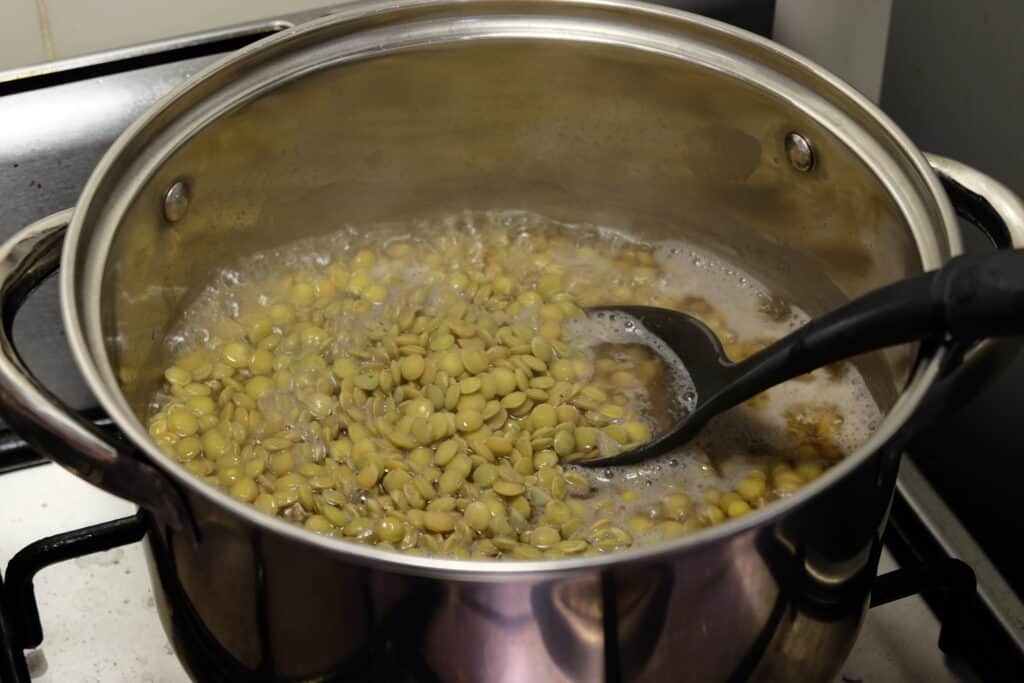Humans have eaten lentils for at least 11,000 years and during that time dogs have lived alongside us, so that begs the question are lentils safe for dogs to eat? They seem fairly bland and risk-free, but let’s uncover whether it’s safe for dogs to eat them too.
Can My Dog Safely Eat Lentils?
Yes, dogs can safely eat lentils in moderation, in fact they are a healthy fibrous addition to a dog’s diet and some major dog food companies are even beginning to include them instead of grains.
Just one thing to note, plain lentils are safe for dogs to eat, but lentils that are spiced up are not. So, for example, a lentil curry is not safe for dogs due to the onions, garlic, salt, and fat levels in it. Any microwavable lentils with extra flavorings are also a strict no.
Stick with a moderate amount of plain cooked lentils and your dog will reap the benefits.

Dogs can safely eat plain cooked lentils in moderation.
©iStock.com/pawel_p
What Are Lentils?
Before we go any further, what exactly are lentils anyway? They’ve been the butt of hippy jokes for years, but are they a grain, seed, or flower?
Lentil plants (Lens culinaris or Lens esculenta) are actually a legume in the Fabaceae family. The lentils we eat are seeds from this annual bushy plant that reaches 16 inches tall and has pea plant-like flowers. Lentil seeds grow just two apiece in one pod!
Native to North America and Asia, they were once a common staple food for Native Americans and the peasants of Europe. There was even evidence of lentil cultivation found near the pyramids of Giza, Egypt. Archaeologists think the laborers were fed a diet that included lentils.
We use the term lentil to describe both the plant and the seed.

The lentils we eat are seeds from this annual bushy plant that reaches 16 inches tall and has pea plant-like flowers.
©Leo Pakhomov/Shutterstock.com
What Are the Risks of Dogs Eating Lentils?
Lentils are full of fiber, so some dogs may find it difficult to digest lentils and become uncomfortable with a gassy stomach. Obviously, this is upsetting for them, and not pleasant for the owners either. Excessive gas can be followed by diarrhea and messy accidents, so always feed your dog a small amount of lentils and take note of their reaction before adding more.
Store-purchased lentils may contain sodium or flavorings which aren’t good for dogs. Sodium increases the risk of hypertension and some spices such as garlic and onions are actually toxic for dogs. Always ensure lentils are plain and don’t add anything when they’re cooked.
Cooking lentils thoroughly also reduces the amount of pectin in them. Pectin is a plant protein found in legumes that isn’t good for dogs because it prevents vitamin and mineral absorption and may cause inflammation, but when lentils are cooked the pectins are destroyed so your pup can enjoy their health benefits safely.

Thoroughly cooking lentils ensures the removal of harmful levels of pectin.
©Alex Dmr/Shutterstock.com
Lentil Health Benefits For Dogs
There are lots of doggy health benefits to be had from lentils.
We know they contain a decent amount of fiber for a healthy digestive tract, but they also contain lots of iron which helps to build red blood cells that carry oxygen around the body. Lentils also contain a large amount of protein which is essential for building muscles, and folate that metabolizes that protein.
Another great benefit from lentils is that they have barely any fat or calories in them, but they’re filling enough to provide satiation. Satiation is that satisfying feeling of having had enough. Hungry dogs are unhappy dogs that hunt out anything to eat. This can lead to them gobbling down anything they can find including those “interesting” yard and pavement grabs!
What Type Of Lentil Is Best? Split or Whole?
Either is fine for a dog as long as it’s plain and well-cooked.
What About the Different Colors?
Humans have eaten lentils for thousands of years, so naturally, there are many cultivars in a rainbow of colors.
Peppery-tasting black, green and brown lentils have their outer coats so they take longer to cook and have more protein and fiber. Red and yellow lentils are usually dehulled so they take less time to cook and have fewer nutrients as a result, but they are sweeter so dogs may prefer the taste.
Named lentils such as Puy lentils are safe for dogs to eat too. They get their name from their area of provenance, for example, Puy lentils are grown in Puy, France.
Lentils without a label are usually brewer lentils grown in North America. They are the most common type in stores and are perfectly safe for dogs in small amounts.

Black, green and brown lentils take longer to cook but have more protein and fiber while red and yellow lentils take less time and have fewer nutrients.
©iStock.com/egal
How Should you Prepare Lentils for Dogs?
As we’ve already discovered lentils should be served up well-cooked and soft. Raw lentils are hard and unappetizing, plus they may get stuck in your dog’s throat and cause irritation.
Some lentils require soaking overnight before they are cooked, just check the label and follow their instruction. Canned lentils are usually pre-cooked and good to go, but rinse away any salty water or preserving liquid first as it may contain flavoring or sodium.
How Many Lentils Can A Dog Eat?
The ASPCA recommends treat foods only make up no more than 10% of a dog’s daily intake. In general, this is a quarter of a cup for a large dog and around a tablespoon for small dogs, however, every dog is different so start out with small amounts and see how they react. Very active dogs can eat more, and sedate dogs less.
Do Lentils Help A Dog’s Diarrhea?
Yes, lentils can help ease dog diarrhea in several ways:
- Lentils are bulky so they help firm up their stools
- They are easy to digest and soothing on a sore gut lining
- They are plain so don’t flare up an existing sore stomach
The best way to feed lentils to a dog with diarrhea is to mix soft, cooked plain lentils with bland meat such as chicken breast and mix it thoroughly. Serve several portions if your dog is unwell again after a big meal.
If the upset continues for more than a few days consult a vet because lentil and chicken is not a balanced meal and frequent diarrhea can cause dehydration.

Lots of fiber, protein, iron, and vitamins mean lentils can boost a dog’s health if they are fed small amounts as part of healthy balanced diet.
©iStock.com/cynoclub
Why Are There Whole Lentils in my Dog’s Poo?
This is nothing to worry about. Sometimes fibrous foods pass straight through the digestive system without breaking down. It also happens with peas, carrots, and tough vegetable or pulse skin such as chickpea skin.
What Foods Dogs Should Avoid
Dogs should not be given the following toxic foods:
- Grapes: including raisins, juice, and wine. They can cause organ failure because dogs can’t digest their compounds.
- Avocados: Avocado stone, skin, and leaves contain a lot of pectin which is toxic to dogs. Although the flesh contains a lesser amount, it’s best to avoid them completely.
- Chocolate: including dark, milk and to a lesser extent white, because it contains the stimulants theobromine and caffeine which dogs can’t absorb. Chocolate can cause swift organ failure.
- Onion: Onions contain several compounds including N-Propyl Disulfide which binds to blood cells and causes anemia.
- Garlic: Garlic is in the same allium family as onions but is more potent. It causes the same anemia as onions and is potentially more harmful due to its concentration of compounds.
- Xylitol: This artificial sweetener creates a drop in blood sugar and potentially fatal hypoglycemia in dogs. It’s in jell-o, cakes, biscuits, juices and lots of sweet treats as an alternative to sugar.
- Macadamia nuts: This nut cannot be digested by dogs and can cause pancreatitis, a painful condition during which the pancreas digests itself.
Lentils Are Safe For Dogs To Eat
All color lentils are safe for dogs to eat in moderate amounts if they are well-cooked and plain.
Not only are they safe, but they are good for Rover. Lots of fiber, protein, iron, and vitamins mean lentils can boost their health if they are fed small amounts as part of healthy balanced diet.
Up Next
- Can Dogs Eat Cottage Cheese? Is it Healthy?
- Can Dogs Eat Edamame, Is it Safe?
- Can Dogs Eat Hummus Safely? What If It’s Flavored?
The photo featured at the top of this post is © iStock.com/joannawnuk
Ready to discover the top 10 cutest dog breeds in the entire world?
How about the fastest dogs, the largest dogs and those that are -- quite frankly -- just the kindest dogs on the planet? Each day, AZ Animals sends out lists just like this to our thousands of email subscribers. And the best part? It's FREE. Join today by entering your email below.
Sources
- Pure Pet Food, Available here: https://www.purepetfood.com/help/can-dogs-eat-lentils
- Toxicology Brief , Available here: https://dungenessranchpetresort.com/images/vetm0805_562_566.pdf
Thank you for reading! Have some feedback for us? Contact the AZ Animals editorial team.






